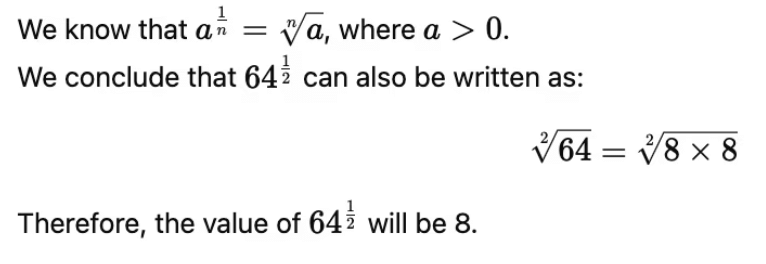Class 9 Maths Chapter 1 Question Answers - Number System
Q1: Simplify: (√5 + √2)2.
Ans:Here, (√5 + √22 = (√52 + 2√5√2 + (√2)2
= 5 + 2√10 + 2
= 7 + 2√10
Q2:How many rational numbers can be found between two distinct rational numbers?
(i) Two
(ii) Ten
(iii) Zero
(iv) Infinite
Ans: (iv) Infinite
Between any two distinct rational numbers, an infinite number of rational numbers can be found. This is because rational numbers are dense on the number line, meaning between any two rational numbers a and b (a<b), you can always find another rational number by calculating the average:
New rational number = a+b/2
Q3: Identify a rational number among the following numbers :
2 + √2, 2√2, 0 and π
Ans: 0 is a rational number.
Q4: √8 is an
(i) natural number
(ii) rational number
(iii) integer
(iv) irrational number
Ans: (D) √8 is an irrational number
Q5: Find the value of √(3)- 2.
Ans: Q6: Is zero a rational number? Can you write it in the form , where p and q are integers and ?
Q6: Is zero a rational number? Can you write it in the form , where p and q are integers and ?
Ans: Consider the definition of a rational number. A rational number is the one that can be written in the form , where p and q are integers and
Zero can be written as
So, we arrive at the conclusion that 0 can be written in the form , where p is any integer.
Therefore, zero is a rational number.
Q7: A terminating decimal is
(i) a natural number
(ii) a rational number
(iii) a whole number
(iv) an integer.
Ans: (ii) a rational number
Q8: Find 641/2
Ans:
Q9: Simplify 
Ans:
 The LCM of 3 and 4 is 12.
The LCM of 3 and 4 is 12.


Q10: The sum of rational and an irrational number
(i) may be natural
(ii) may be irrational
(iii) is always irrational
(iv) is always rational
Ans: (iii) is always rational
Example:
Rational number: 3
Irrational number:
Sum: √
The sum √ cannot be expressed as , so it is irrational.
|
40 videos|471 docs|57 tests
|
FAQs on Class 9 Maths Chapter 1 Question Answers - Number System
| 1. What are the different types of number systems? |  |
| 2. How do you convert a binary number to decimal? |  |
| 3. What is the importance of number systems in computer science? |  |
| 4. How do you convert a decimal number to binary? |  |
| 5. What is the difference between signed and unsigned numbers in binary? |  |






















